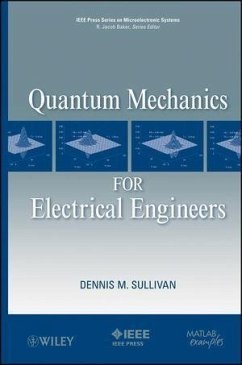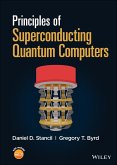Quantum Mechanics for Electrical Engineers (eBook, ePUB)


Alle Infos zum eBook verschenken

Quantum Mechanics for Electrical Engineers (eBook, ePUB)
- Format: ePub
- Merkliste
- Auf die Merkliste
- Bewerten Bewerten
- Teilen
- Produkt teilen
- Produkterinnerung
- Produkterinnerung

Hier können Sie sich einloggen

Bitte loggen Sie sich zunächst in Ihr Kundenkonto ein oder registrieren Sie sich bei bücher.de, um das eBook-Abo tolino select nutzen zu können.
The main topic of this book is quantum mechanics, as the title indicates. It specifically targets those topics within quantum mechanics that are needed to understand modern semiconductor theory. It begins with the motivation for quantum mechanics and why classical physics fails when dealing with very small particles and small dimensions. Two key features make this book different from others on quantum mechanics, even those usually intended for engineers: First, after a brief introduction, much of the development is through Fourier theory, a topic that is at the heart of most electrical…mehr
- Geräte: eReader
- mit Kopierschutz
- eBook Hilfe
- Größe: 10.83MB
![Quantum Mechanics for Electrical Engineers (eBook, PDF) Quantum Mechanics for Electrical Engineers (eBook, PDF)]() Dennis M. SullivanQuantum Mechanics for Electrical Engineers (eBook, PDF)93,99 €
Dennis M. SullivanQuantum Mechanics for Electrical Engineers (eBook, PDF)93,99 €![Engineering Quantum Mechanics (eBook, ePUB) Engineering Quantum Mechanics (eBook, ePUB)]() Doyeol AhnEngineering Quantum Mechanics (eBook, ePUB)127,99 €
Doyeol AhnEngineering Quantum Mechanics (eBook, ePUB)127,99 €![Engineering Quantum Mechanics (eBook, PDF) Engineering Quantum Mechanics (eBook, PDF)]() Doyeol AhnEngineering Quantum Mechanics (eBook, PDF)127,99 €
Doyeol AhnEngineering Quantum Mechanics (eBook, PDF)127,99 €![Advanced Quantum Communications (eBook, ePUB) Advanced Quantum Communications (eBook, ePUB)]() Sandor ImreAdvanced Quantum Communications (eBook, ePUB)132,99 €
Sandor ImreAdvanced Quantum Communications (eBook, ePUB)132,99 €![Reversible Computing (eBook, ePUB) Reversible Computing (eBook, ePUB)]() Alexis De VosReversible Computing (eBook, ePUB)117,99 €
Alexis De VosReversible Computing (eBook, ePUB)117,99 €![Principles of Superconducting Quantum Computers (eBook, ePUB) Principles of Superconducting Quantum Computers (eBook, ePUB)]() Daniel D. StancilPrinciples of Superconducting Quantum Computers (eBook, ePUB)83,99 €
Daniel D. StancilPrinciples of Superconducting Quantum Computers (eBook, ePUB)83,99 €![Nuclear Electronics with Quantum Cryogenic Detectors (eBook, ePUB) Nuclear Electronics with Quantum Cryogenic Detectors (eBook, ePUB)]() Vladimir PolushkinNuclear Electronics with Quantum Cryogenic Detectors (eBook, ePUB)127,99 €
Vladimir PolushkinNuclear Electronics with Quantum Cryogenic Detectors (eBook, ePUB)127,99 €-
-
-
Dieser Download kann aus rechtlichen Gründen nur mit Rechnungsadresse in A, B, BG, CY, CZ, D, DK, EW, E, FIN, F, GR, HR, H, IRL, I, LT, L, LR, M, NL, PL, P, R, S, SLO, SK ausgeliefert werden.
- Produktdetails
- Verlag: John Wiley & Sons
- Seitenzahl: 448
- Erscheinungstermin: 29. November 2011
- Englisch
- ISBN-13: 9781118169797
- Artikelnr.: 37486451
- Verlag: John Wiley & Sons
- Seitenzahl: 448
- Erscheinungstermin: 29. November 2011
- Englisch
- ISBN-13: 9781118169797
- Artikelnr.: 37486451
1 1.1.1 Photoelectric Effect
1 1.1.2 Wave-Particle Duality
2 1.1.3 Energy Equations
3 1.1.4 The Schrödinger Equation
5 1.2 Simulation of the One-Dimensional
Time-Dependent Schrödinger Equation
7 1.2.1 Propagation of a Particle in Free Space
8 1.2.2 Propagation of a Particle Interacting with a Potential
11 1.3 Physical Parameters: The Observables
14 1.4 The Potential V(x)
17 1.4.1 The Conduction Band of a Semiconductor
17 1.4.2 A Particle in an Electric Field
17 1.5 Propagating through Potential Barriers
20 1.6 Summary
23 Exercises
24 References
25 2. Stationary States 27 2.1 The Infi nite Well
28 2.1.1 Eigenstates and Eigenenergies
30 2.1.2 Quantization
33 2.2 Eigenfunction Decomposition
34 2.3 Periodic Boundary Conditions
38 2.4 Eigenfunctions for Arbitrarily Shaped Potentials
39 2.5 Coupled Wells
41 2.6 Bra-ket Notation
44 2.7 Summary
47 Exercises
47 References
49 3. Fourier Theory in Quantum Mechanics 51 3.1 The Fourier Transform
51 3.2 Fourier Analysis and Available States
55 3.3 Uncertainty
59 3.4 Transmission via FFT
62 3.5 Summary
66 Exercises
67 References
69 4. Matrix Algebra in Quantum Mechanics 71 4.1 Vector and Matrix Representation
71 4.1.1 State Variables as Vectors
71 4.1.2 Operators as Matrices
73 4.2 Matrix Representation of the Hamiltonian
76 4.2.1 Finding the Eigenvalues and Eigenvectors of a Matrix
77 4.2.2 A Well with Periodic Boundary Conditions
77 4.2.3 The Harmonic Oscillator
80 4.3 The Eigenspace Representation
81 4.4 Formalism
83 4.4.1 Hermitian Operators
83 4.4.2 Function Spaces
84 Appendix: Review of Matrix Algebra
85 Exercises
88 References
90 5. A Brief Introduction to Statistical Mechanics 91 5.1 Density of States
91 5.1.1 One-Dimensional Density of States
92 5.1.2 Two-Dimensional Density of States
94 5.1.3 Three-Dimensional Density of States
96 5.1.4 The Density of States in the Conduction Band of a Semiconductor
97 5.2 Probability Distributions
98 5.2.1 Fermions versus Classical Particles
98 5.2.2 Probability Distributions as a Function of Energy
99 5.2.3 Distribution of Fermion Balls
101 5.2.4 Particles in the One-Dimensional Infi nite Well
105 5.2.5 Boltzmann Approximation
106 5.3 The Equilibrium Distribution of Electrons and Holes
107 5.4 The Electron Density and the Density Matrix
110 5.4.1 The Density Matrix
111 Exercises
113 References
114 6. Bands and Subbands 115 6.1 Bands in Semiconductors
115 6.2 The Effective Mass
118 6.3 Modes (Subbands) in Quantum Structures
123 Exercises
128 References
129 7. The Schrödinger Equation for Spin-1/2 Fermions 131 7.1 Spin in Fermions
131 7.1.1 Spinors in Three Dimensions
132 7.1.2 The Pauli Spin Matrices
135 7.1.3 Simulation of Spin
136 7.2 An Electron in a Magnetic Field
142 7.3 A Charged Particle Moving in Combined E and B Fields
146 7.4 The Hartree-Fock Approximation
148 7.4.1 The Hartree Term
148 7.4.2 The Fock Term
153 Exercises
155 References
157 8. The Green's Function Formulation 159 8.1 Introduction
160 8.2 The Density Matrix and the Spectral Matrix
161 8.3 The Matrix Version of the Green's Function
164 8.3.1 Eigenfunction Representation of Green's Function
165 8.3.2 Real Space Representation of Green's Function
167 8.4 The Self-Energy Matrix
169 8.4.1 An Electric Field across the Channel
174 8.4.2 A Short Discussion on Contacts
175 Exercises
176 References
176 9. Transmission 177 9.1 The Single-Energy Channel
177 9.2 Current Flow
179 9.3 The Transmission Matrix
181 9.3.1 Flow into the Channel
183 9.3.2 Flow out of the Channel
184 9.3.3 Transmission
185 9.3.4 Determining Current Flow
186 9.4 Conductance
189 9.5 Büttiker Probes
191 9.6 A Simulation Example
194 Exercises
196 References
197 10. Approximation Methods 199 10.1 The Variational Method
199 10.2 Nondegenerate Perturbation Theory
202 10.2.1 First-Order Corrections
203 10.2.2 Second-Order Corrections
206 10.3 Degenerate Perturbation Theory
206 10.4 Time-Dependent Perturbation Theory
209 10.4.1 An Electric Field Added to an Infinite Well
212 10.4.2 Sinusoidal Perturbations
213 10.4.3 Absorption
Emission
and Stimulated Emission
215 10.4.4 Calculation of Sinusoidal Perturbations Using Fourier Theory
216 10.4.5 Fermi's Golden Rule
221 Exercises
223 References
225 11. The Harmonic Oscillator 227 11.1 The Harmonic Oscillator in One Dimension
227 11.1.1 Illustration of the Harmonic Oscillator Eigenfunctions
232 11.1.2 Compatible Observables
233 11.2 The Coherent State of the Harmonic Oscillator
233 11.2.1 The Superposition of Two Eigentates in an Infinite Well
234 11.2.2 The Superposition of Four Eigenstates in a Harmonic Oscillator
235 11.2.3 The Coherent State
236 11.3 The Two-Dimensional Harmonic Oscillator
238 11.3.1 The Simulation of a Quantum Dot
238 Exercises
244 References
244 12. Finding Eigenfunctions Using Time-Domain Simulation 245 12.1 Finding the Eigenenergies and Eigenfunctions in One Dimension
245 12.1.1 Finding the Eigenfunctions
248 12.2 Finding the Eigenfunctions of Two-Dimensional Structures
249 12.2.1 Finding the Eigenfunctions in an Irregular Structure
252 12.3 Finding a Complete Set of Eigenfunctions
257 Exercises
259 References
259 Appendix A. Important Constants and Units 261 Appendix B. Fourier Analysis and the Fast Fourier Transform (FFT) 265 B.1 The Structure of the FFT
265 B.2 Windowing
267 B.3 FFT of the State Variable
270 Exercises
271 References
271 Appendix C. An Introduction to the Green's Function Method 273 C.1 A One-Dimensional Electromagnetic Cavity
275 Exercises
279 References
279 Appendix D. Listings of the Programs Used in this Book 281 D.1 Chapter 1
281 D.2 Chapter 2
284 D.3 Chapter 3
295 D.4 Chapter 4
309 D.5 Chapter 5
312 D.6 Chapter 6
314 D.7 Chapter 7
323 D.8 Chapter 8
336 D.9 Chapter 9
345 D.10 Chapter 10
356 D.11 Chapter 11
378 D.12 Chapter 12
395 D.13 Appendix B
415 Index 419 MATLAB Coes are downloadable from http://booksupport.wiley.com
1 1.1.1 Photoelectric Effect
1 1.1.2 Wave-Particle Duality
2 1.1.3 Energy Equations
3 1.1.4 The Schrödinger Equation
5 1.2 Simulation of the One-Dimensional
Time-Dependent Schrödinger Equation
7 1.2.1 Propagation of a Particle in Free Space
8 1.2.2 Propagation of a Particle Interacting with a Potential
11 1.3 Physical Parameters: The Observables
14 1.4 The Potential V(x)
17 1.4.1 The Conduction Band of a Semiconductor
17 1.4.2 A Particle in an Electric Field
17 1.5 Propagating through Potential Barriers
20 1.6 Summary
23 Exercises
24 References
25 2. Stationary States 27 2.1 The Infi nite Well
28 2.1.1 Eigenstates and Eigenenergies
30 2.1.2 Quantization
33 2.2 Eigenfunction Decomposition
34 2.3 Periodic Boundary Conditions
38 2.4 Eigenfunctions for Arbitrarily Shaped Potentials
39 2.5 Coupled Wells
41 2.6 Bra-ket Notation
44 2.7 Summary
47 Exercises
47 References
49 3. Fourier Theory in Quantum Mechanics 51 3.1 The Fourier Transform
51 3.2 Fourier Analysis and Available States
55 3.3 Uncertainty
59 3.4 Transmission via FFT
62 3.5 Summary
66 Exercises
67 References
69 4. Matrix Algebra in Quantum Mechanics 71 4.1 Vector and Matrix Representation
71 4.1.1 State Variables as Vectors
71 4.1.2 Operators as Matrices
73 4.2 Matrix Representation of the Hamiltonian
76 4.2.1 Finding the Eigenvalues and Eigenvectors of a Matrix
77 4.2.2 A Well with Periodic Boundary Conditions
77 4.2.3 The Harmonic Oscillator
80 4.3 The Eigenspace Representation
81 4.4 Formalism
83 4.4.1 Hermitian Operators
83 4.4.2 Function Spaces
84 Appendix: Review of Matrix Algebra
85 Exercises
88 References
90 5. A Brief Introduction to Statistical Mechanics 91 5.1 Density of States
91 5.1.1 One-Dimensional Density of States
92 5.1.2 Two-Dimensional Density of States
94 5.1.3 Three-Dimensional Density of States
96 5.1.4 The Density of States in the Conduction Band of a Semiconductor
97 5.2 Probability Distributions
98 5.2.1 Fermions versus Classical Particles
98 5.2.2 Probability Distributions as a Function of Energy
99 5.2.3 Distribution of Fermion Balls
101 5.2.4 Particles in the One-Dimensional Infi nite Well
105 5.2.5 Boltzmann Approximation
106 5.3 The Equilibrium Distribution of Electrons and Holes
107 5.4 The Electron Density and the Density Matrix
110 5.4.1 The Density Matrix
111 Exercises
113 References
114 6. Bands and Subbands 115 6.1 Bands in Semiconductors
115 6.2 The Effective Mass
118 6.3 Modes (Subbands) in Quantum Structures
123 Exercises
128 References
129 7. The Schrödinger Equation for Spin-1/2 Fermions 131 7.1 Spin in Fermions
131 7.1.1 Spinors in Three Dimensions
132 7.1.2 The Pauli Spin Matrices
135 7.1.3 Simulation of Spin
136 7.2 An Electron in a Magnetic Field
142 7.3 A Charged Particle Moving in Combined E and B Fields
146 7.4 The Hartree-Fock Approximation
148 7.4.1 The Hartree Term
148 7.4.2 The Fock Term
153 Exercises
155 References
157 8. The Green's Function Formulation 159 8.1 Introduction
160 8.2 The Density Matrix and the Spectral Matrix
161 8.3 The Matrix Version of the Green's Function
164 8.3.1 Eigenfunction Representation of Green's Function
165 8.3.2 Real Space Representation of Green's Function
167 8.4 The Self-Energy Matrix
169 8.4.1 An Electric Field across the Channel
174 8.4.2 A Short Discussion on Contacts
175 Exercises
176 References
176 9. Transmission 177 9.1 The Single-Energy Channel
177 9.2 Current Flow
179 9.3 The Transmission Matrix
181 9.3.1 Flow into the Channel
183 9.3.2 Flow out of the Channel
184 9.3.3 Transmission
185 9.3.4 Determining Current Flow
186 9.4 Conductance
189 9.5 Büttiker Probes
191 9.6 A Simulation Example
194 Exercises
196 References
197 10. Approximation Methods 199 10.1 The Variational Method
199 10.2 Nondegenerate Perturbation Theory
202 10.2.1 First-Order Corrections
203 10.2.2 Second-Order Corrections
206 10.3 Degenerate Perturbation Theory
206 10.4 Time-Dependent Perturbation Theory
209 10.4.1 An Electric Field Added to an Infinite Well
212 10.4.2 Sinusoidal Perturbations
213 10.4.3 Absorption
Emission
and Stimulated Emission
215 10.4.4 Calculation of Sinusoidal Perturbations Using Fourier Theory
216 10.4.5 Fermi's Golden Rule
221 Exercises
223 References
225 11. The Harmonic Oscillator 227 11.1 The Harmonic Oscillator in One Dimension
227 11.1.1 Illustration of the Harmonic Oscillator Eigenfunctions
232 11.1.2 Compatible Observables
233 11.2 The Coherent State of the Harmonic Oscillator
233 11.2.1 The Superposition of Two Eigentates in an Infinite Well
234 11.2.2 The Superposition of Four Eigenstates in a Harmonic Oscillator
235 11.2.3 The Coherent State
236 11.3 The Two-Dimensional Harmonic Oscillator
238 11.3.1 The Simulation of a Quantum Dot
238 Exercises
244 References
244 12. Finding Eigenfunctions Using Time-Domain Simulation 245 12.1 Finding the Eigenenergies and Eigenfunctions in One Dimension
245 12.1.1 Finding the Eigenfunctions
248 12.2 Finding the Eigenfunctions of Two-Dimensional Structures
249 12.2.1 Finding the Eigenfunctions in an Irregular Structure
252 12.3 Finding a Complete Set of Eigenfunctions
257 Exercises
259 References
259 Appendix A. Important Constants and Units 261 Appendix B. Fourier Analysis and the Fast Fourier Transform (FFT) 265 B.1 The Structure of the FFT
265 B.2 Windowing
267 B.3 FFT of the State Variable
270 Exercises
271 References
271 Appendix C. An Introduction to the Green's Function Method 273 C.1 A One-Dimensional Electromagnetic Cavity
275 Exercises
279 References
279 Appendix D. Listings of the Programs Used in this Book 281 D.1 Chapter 1
281 D.2 Chapter 2
284 D.3 Chapter 3
295 D.4 Chapter 4
309 D.5 Chapter 5
312 D.6 Chapter 6
314 D.7 Chapter 7
323 D.8 Chapter 8
336 D.9 Chapter 9
345 D.10 Chapter 10
356 D.11 Chapter 11
378 D.12 Chapter 12
395 D.13 Appendix B
415 Index 419 MATLAB Coes are downloadable from http://booksupport.wiley.com







